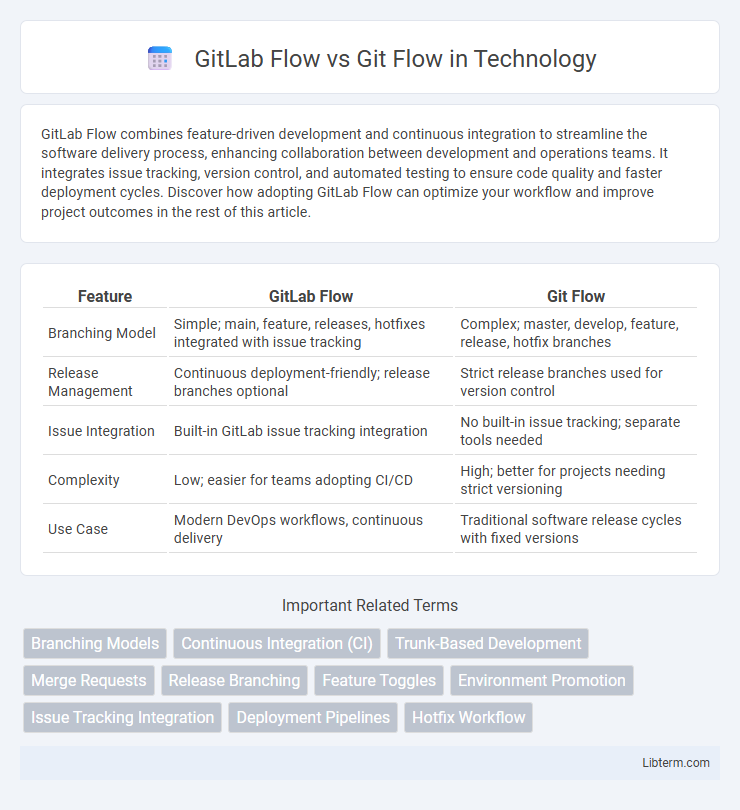GitLab Flow combines feature-driven development and continuous integration to streamline the software delivery process, enhancing collaboration between development and operations teams. It integrates issue tracking, version control, and automated testing to ensure code quality and faster deployment cycles. Discover how adopting GitLab Flow can optimize your workflow and improve project outcomes in the rest of this article.
Table of Comparison
| Feature | GitLab Flow | Git Flow |
|---|---|---|
| Branching Model | Simple; main, feature, releases, hotfixes integrated with issue tracking | Complex; master, develop, feature, release, hotfix branches |
| Release Management | Continuous deployment-friendly; release branches optional | Strict release branches used for version control |
| Issue Integration | Built-in GitLab issue tracking integration | No built-in issue tracking; separate tools needed |
| Complexity | Low; easier for teams adopting CI/CD | High; better for projects needing strict versioning |
| Use Case | Modern DevOps workflows, continuous delivery | Traditional software release cycles with fixed versions |
Introduction to GitLab Flow and Git Flow
GitLab Flow integrates issue tracking and CI/CD pipelines, streamlining collaboration by combining feature-driven development with environment-based deployment. Git Flow emphasizes a strict branching model with distinct branches for features, releases, and hotfixes, optimizing release management and version control. Both methodologies enhance Git workflows but GitLab Flow offers more agility by aligning with modern DevOps practices and continuous integration strategies.
Core Concepts and Workflow Structures
GitLab Flow integrates feature-driven development and issue tracking by combining branch strategies with issue boards, promoting continuous integration and delivery through environment branches like production, staging, and pre-production. Git Flow uses a rigid branching model with long-lived branches including feature, develop, release, and hotfix branches to manage distinct phases of development and deployment. GitLab Flow emphasizes simplicity and collaboration with flexible workflows, while Git Flow enforces strict roles for branches to facilitate larger projects requiring formal release management.
Branching Strategies Compared
GitLab Flow combines feature-driven development with environment-based deployment branches, enhancing collaboration through environment branches like production and staging. Git Flow uses a strict branch hierarchy with long-lived develop and master branches and supporting feature, release, and hotfix branches, emphasizing structured release management. GitLab Flow streamlines deployment and continuous integration with simpler branching, while Git Flow provides clear separation of development phases but can create more complex merge processes.
Feature Development in Both Workflows
GitLab Flow emphasizes continuous integration and continuous delivery by integrating feature branches directly into the main branch, promoting frequent merges and streamlined collaboration, which accelerates feature development and deployment cycles. Git Flow relies on a structured branching model with dedicated feature branches isolated from the main line until completion, offering controlled releases but potentially slower integration. Feature development in GitLab Flow benefits from simplified workflows and quicker feedback, whereas Git Flow provides clear versioning and release management at the cost of more complex branching and merging processes.
Release Management Approaches
GitLab Flow integrates continuous integration and continuous delivery with environment-based deployment, streamlining release management by combining feature-driven and release branch workflows for more frequent, stable releases. Git Flow centers on rigid release branches and predefined roles for development, release, and hotfix branches, emphasizing controlled, scheduled releases with clear versioning. GitLab Flow's flexibility supports modern DevOps practices, enabling faster deployment cycles compared to Git Flow's traditional, linear release management approach.
Integration and Deployment Practices
GitLab Flow emphasizes continuous integration and continuous deployment (CI/CD) by integrating feature branching with environment-based workflows, enabling faster and more automated releases. Git Flow relies on rigid branching models with separate branches for features, releases, and hotfixes, which can slow down deployment cycles and complicate integration. GitLab Flow's approach supports seamless integration with CI/CD pipelines, reducing integration conflicts and facilitating more frequent, reliable deployments.
Collaboration and Code Review Processes
GitLab Flow prioritizes streamlined collaboration by integrating issue tracking and merge requests, enabling continuous integration and easier code reviews within a single platform. Git Flow uses a more rigid branching model with feature, develop, release, and hotfix branches, which can complicate collaboration but provides clear separation of development stages. GitLab Flow's approach fosters real-time feedback and iterative improvements, optimizing team collaboration and accelerating the code review process.
Common Use Cases and Scenarios
GitLab Flow integrates feature-driven development with issue tracking, making it ideal for continuous integration and continuous deployment (CI/CD) pipelines in Agile environments. Git Flow suits release-based projects with clearly defined stages such as development, release, and hotfix branches, often preferred in traditional software development cycles. Teams focused on fast iteration and customer feedback often adopt GitLab Flow, while Git Flow excels in managing parallel development and version control for complex, multi-release projects.
Advantages and Limitations
GitLab Flow offers a streamlined integration of feature-driven development with continuous deployment pipelines, enhancing collaboration between development and operations teams by combining issue tracking and merge requests. It provides flexible environment-based branching, enabling faster release cycles and more efficient code management, but its reliance on environment branches can complicate workflows for teams with less mature DevOps practices. Git Flow, while robust and suitable for projects requiring strict release management with clearly defined feature, release, and hotfix branches, often results in slower iteration speeds and can introduce complexity that hinders continuous integration and continuous delivery efforts.
Choosing the Best Workflow for Your Team
GitLab Flow integrates feature-driven development with continuous integration and deployment, streamlining collaboration by combining issue tracking and environment branches for enhanced transparency and faster releases. Git Flow emphasizes strict branch management with separate development, feature, release, and hotfix branches, ideal for projects requiring controlled versioning and formal release cycles. Choosing the best workflow depends on your team's size, project complexity, and release frequency, with GitLab Flow favoring agile, continuous delivery environments and Git Flow suited for traditional, stage-based development.
GitLab Flow Infographic

 libterm.com
libterm.com